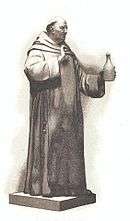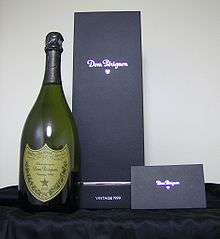Dom Pérignon

Dom Pérignon (/ˌdɒmpɛrɪˈnjɒn/; French pronunciation: [dɔ̃ peʁiɲɔ̃]) is a brand of vintage Champagne produced by the Champagne house Moët & Chandon and serves as that house's prestige champagne. It is named after Dom Pérignon, a Benedictine monk who was an important quality pioneer for Champagne wine but who, contrary to popular myths, did not discover the champagne method for making sparkling wines.[1]
History
Dom Pérignon (1638–1715) was a monk and cellar master at the Benedictine abbey in Hautvillers. He pioneered a number of winemaking techniques around 1670—being the first to blend grapes in such a way as to improve the quality of wines, balance one element with another in order to make a better whole, and deal with a number of their imperfections; perfecting the art of producing clear white wines from black grapes by clever manipulation of the presses; enhancing the tendency of Champagne wines to retain their natural sugar in order to naturally induce secondary fermentation in the Spring; being a master at deciding when to bottle these wines in order to capture the bubble. He also introduced corks (instead of wood), which were fastened to bottles with hemp string soaked in oil in order to keep the wines fresh and sparkling, and used thicker glass in order to strengthen the bottles (which were prone to explode at that time).[2] The development of sparkling wines as the main style of production in Champagne occurred progressively in the 19th century, more than a century after Dom Pérignon's death.

Dom Pérignon was the first prestige cuvée Champagne introduced, an idea proposed by Englishman Laurence Venn.[3] The first vintage of Dom Pérignon was 1921 and was only released for sale in 1936, sailing to New York in the liner Normandie.[4] The brand, not exploited, was given by Champagne Mercier to Moët in 1927 for a wedding between the two families.

The first buyers of Dom Pérignon 1921 were 150 customers of Simon Bros. & Co., the company that imported Moët in the United Kingdom, which ordered the first 300 bottles. The wine got immediate attention in the marketplace and 100 boxes were shipped to the United States shortly thereafter. James Buchanan Duke, the billionaire who had founded the American Tobacco Company, ordered 100 bottles for himself. The 17 bottles sold at an auction in Christie's in New York City in June 2004 were part of that order (Doris Duke, the billionaire’s daughter, had kept them in her cellar). According to current Dom Pérignon cellar master Richard Geoffroy (2012), who has been Chef de Cave for Dom Pérignon since 1990, the 1921 vintage had a "distinctive bouquet comprising sandalwood, vanilla and praline".[5]
Until the 1943 vintage, Dom Pérignon was produced from regular vintage Moët & Chandon Champagne that was transferred to the special 18th century-style bottles after extended cellaring. It was, thus, effectively an "oenothèque" release of Moët & Chandon Vintage Champagne in a different bottle. From the 1947 vintage, Dom Pérignon has been produced separately from the start.[6]
In 1971, the Shah of Iran ordered several bottles of the first vintage of Dom Pérignon Rosé (the 1959) for the 2,500 year celebration of the Persian Empire. A bottle of that champagne, from that order, was sold at auction for €24,758 in 2008.[7]
In 1981, Dom Pérignon was chosen for the wedding of Lady Diana Spencer and Prince Charles. The magnums of Dom Pérignon Vintage 1961 served on that July 29 carried a special insignia created just for the ceremony.[8]
Vintages
Dom Pérignon is always a vintage champagne, meaning that it is not made in weak years, and all grapes used to make the wine were harvested in the same year. [9]
From 1921 to 2005, Dom Pérignon champagne has been produced in 41 vintages. More than two vintage years in a row used to be a rare phenomenon, which until 2004 had only occurred three times: in 1969, 1970, and 1971; in 1998, 1999, and 2000; in 2002, 2003, and 2004. 2005 marked the first time when four vintages had been produced in a row.
The 41 white Dom Pérignon vintages up to 2006 are: 1921, 1926, 1928, 1929, 1934, 1943, 1947, 1949, 1952, 1953, 1955, 1959, 1961, 1962, 1964, 1966, 1969, 1970, 1971, 1973, 1975, 1976, 1978, 1980, 1982, 1983, 1985, 1988, 1990, 1992, 1993, 1995, 1996, 1998, 1999, 2000, 2002, 2003, 2004, 2005 and 2006.[10]
Since 1959 a rosé version of Dom Pérignon is also produced. 24 Dom Pérignon Rosé vintages have been produced until 2004: 1959, 1962, 1964, 1966, 1969, 1971, 1973, 1975, 1978, 1980, 1982, 1985, 1986 (the only rosé vintage where the white version was not produced), 1988, 1990, 1992, 1993, 1995, 1996, 1998, 2000, 2002, 2003, and 2004.[10]
Style
Dom Pérignon is always an assemblage of Pinot noir and Chardonnay grapes, although the final composition changes every vintage: at times a blend in perfectly equal proportions (e.g. 1990 Rosé), at times up to 60% Chardonnay (1982) or 60% Pinot noir (1969), and only once going over 60% (with 65% Chardonnay in 1970).[11] According to Richard Geoffroy's Manifesto and blog: "Dom Pérignon expresses its first plénitude after seven years in the cellar", with a second plénitude 12 to 15 years after the vintage (first Œnothèque release) and a third plénitude after 30 to 40 years (second Œnothèque release).[12][13] The grapes entering the blend come from the best, most sunlit sites. Serena Sutcliffe comments: "With age, Dom Pérignon takes on a totally seductive fresh-toast-and-coffee bouquet, one of the most intriguing scents in Champagne."[4]
Current production
The number of bottles produced in each vintage is not precisely defined (at least 2 million[14][15][3]).
As of November 2015, the current release of Dom Pérignon is from the 2006 vintage and the current release of Dom Pérignon Rosé is from the 2004 vintage. [10]
Auction market
Dom Pérignon is often traded at wine auctions. A recent wave of auction price records started in 2004, with the sale of the Doris Duke collection at Christie’s in New York City. Three bottles of Dom Pérignon 1921 sold for US$24,675. In 2008, two sales held by Acker Merrall & Condit also left their mark on the history of Dom Pérignon, with three magnums of Dom Pérignon Œnothèque (1966, 1973 and 1976) selling for US$93,260 in Hong Kong, and a lot of two bottles of the legendary Dom Pérignon Rosé Vintage 1959 selling for US$84,700 in New York. Only 306 bottles of the 1959 Rosé Vintage were produced, and they were never sold. In 1971, it was served in Persepolis at the lavish festivities celebrating the 2500th anniversary of the founding of the Persian Empire by Cyrus the Great.[16]
On April 17, 2010 a new record was set for a sale of wine in Britain according to The Daily Telegraph. A buyer would have spent more than £35,000 for Methuselah (6 litre) 1996 Dom Perignon Champagne Rose (Rose Gold). This transaction took place at the Westbury Hotel at a party that followed the screening of the new film, Boogie Woogie.[17]
A vertical of Dom Pérignon Rosé Œnothèque, a world premiere release from the reserve cellar of Dom Pérignon, never commercially released before, was sold at a record price at a wine auction organized by Sotheby's in Hong Kong in May 2010.[18] The 30 bottle lot of Dom Pérignon Œnothèque Rosé bottles and magnums from 1966, 1978, 1982, 1985, 1988, and 1990 achieved HK$1,331,000 (US$170,641), setting the world auction record for a single lot of champagne and is the first HK$1 million lot of wine Sotheby’s has sold in Hong Kong.
Footnotes
- ↑ D. & P. Kladstrup Champagne, p. 38 Harper Collins Publisher, ISBN 0-06-073792-1
- ↑ Sutcliffe, Serena, "A Celebration of Champagne", pp. 13–14, Mitchell Beazley 1988, ISBN 0-85-533697-8
- 1 2 Stevenson, Tom, Decanter (December 2007) "The Best A Man Can Get", p.65
- 1 2 Sutcliffe, Serena, "A Celebration of Champagne", p. 130, Mitchell Beazley 1988, ISBN 0-85-533697-8
- ↑ richardgeoffroy-domperignon.com Blog of Dom Pérignon cellar master Richard Geoffroy
- ↑ Richard Juhlin, Champagne Guide, Richard Juhlin Publishing, 2008, p. 315, ISBN 978-91-633-3190-9
- ↑ Goldberg, Howard G., Decanter.com (April 29, 2008). "Acker Merrall sells 'Shah's Champagne'"
- ↑ Celeste, Rigel, Luxist.com (February 28, 2010). Dom Pérignon Wedding
- ↑ Dom Pérignon website - vintages http://www.domperignon.com/image/home-vintages/
- 1 2 3 Dom Pérignon website - vintage archives http://www.domperignon.com/image/vintages-archives/
- ↑ "Dom Pérignon assemblage". creatingdomperignon.com/. Retrieved 5 June 2011.
- ↑ "Dom Pérignon's Manifesto". creatingdomperignon.com/. Retrieved 14 September 2012.
- ↑ "http://www.creatingdomperignon.com/plenitudes/". creatingdomperignon.com/. 6 October 2010. Retrieved 14 September 2012. External link in
|title=(help) - ↑ Bottles produced: 2 millions here
- ↑ Bottles produced: 4 millions there
- ↑ finewine.finewinepress.com Acker Merrall & Condit HK sale shatters all records
- ↑ The Daily Telegraph (April 17, 2010). Bottle of vintage Dom Perignon bought in bar for £35,000
- ↑ sothebys.com Sotheby's auction page
References
- Stevenson, Tom. World Encyclopedia of Champagne and Sparkling Wine (Fully rev. and updated ed.). South San Francisco, California: The Wine Appreciation Guild, 2003. ISBN 1-891267-61-2.
External links
| Wikimedia Commons has media related to Dom Pérignon. |